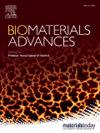Macrophage and osteosarcoma cell crosstalk is dependent on oxygen tension and 3D culture
IF 5.5
2区 医学
Q2 MATERIALS SCIENCE, BIOMATERIALS
Materials Science & Engineering C-Materials for Biological Applications
Pub Date : 2024-12-16
DOI:10.1016/j.bioadv.2024.214154
引用次数: 0
Abstract
Osteosarcoma (OS), the most common form of primary bone cancer in young adults, has had no improvements in clinical outcomes in 50 years. This highlights a critical need to advance mechanistic understanding of OS to further therapeutic discovery, which will only be possible with accurate models of the disease. Compared to traditional monolayer studies and preclinical models, in vitro models that better replicate the three-dimensional (3D) bone marrow microenvironment will facilitate methodical investigations of the events and factors that drive OS progression. Herein, we use fibrin-alginate interpenetrating network (FA IPN) hydrogels to model the hematological bone marrow environment. We interrogated the effects of oxygen tension, 3D culture, and macrophage phenotype on OS behavior and specifically examine the immunomodulatory crosstalk between OS and macrophages. We observe that OS is more sensitive to oxygen tension when cultured in 3D. Specifically, both highly and less metastatic OS exhibit decreased changes in DNA content over time in 3D, but then demonstrate diverging behaviors in heterotypic culture with macrophages. OS response to macrophages differs as a function of metastatic potential, where highly metastatic OS shows increased immunosuppression that varies with oxygen tension but relies on direct coculture conditions. To our knowledge, this is among the first work to report the effects of 3D culture on the interplay between OS and macrophages in a coculture microenvironment. Together, these data introduce FA IPNs as a promising platform for cancer research and emphasize the importance of novel models for the mechanistic study of OS.

巨噬细胞和骨肉瘤细胞的串扰依赖于氧张力和三维培养。
骨肉瘤(OS)是年轻人中最常见的原发性骨癌,50年来在临床结果上没有任何改善。这凸显了迫切需要推进对OS的机制理解,以进一步发现治疗方法,这只有通过准确的疾病模型才有可能实现。与传统的单层研究和临床前模型相比,体外模型更好地复制了三维(3D)骨髓微环境,将有助于系统地研究驱动OS进展的事件和因素。在这里,我们使用纤维蛋白-海藻酸互穿网络(FA IPN)水凝胶来模拟血液骨髓环境。我们研究了氧张力、3D培养和巨噬细胞表型对OS行为的影响,并专门研究了OS和巨噬细胞之间的免疫调节串扰。我们观察到OS在3D培养时对氧张力更敏感。具体来说,高转移性和低转移性OS在3D中随着时间的推移都表现出DNA含量的变化减少,但随后在巨噬细胞异型培养中表现出不同的行为。OS对巨噬细胞的反应因转移潜能的不同而不同,其中高度转移的OS表现出随氧张力变化而增加的免疫抑制,但依赖于直接共培养条件。据我们所知,这是首次报道3D培养对共培养微环境中OS和巨噬细胞之间相互作用的影响。总之,这些数据介绍了FA ipn作为癌症研究的一个有前途的平台,并强调了新模型对OS机制研究的重要性。
本文章由计算机程序翻译,如有差异,请以英文原文为准。
求助全文
约1分钟内获得全文
求助全文
来源期刊
CiteScore
17.80
自引率
0.00%
发文量
501
审稿时长
27 days
期刊介绍:
Biomaterials Advances, previously known as Materials Science and Engineering: C-Materials for Biological Applications (P-ISSN: 0928-4931, E-ISSN: 1873-0191). Includes topics at the interface of the biomedical sciences and materials engineering. These topics include:
• Bioinspired and biomimetic materials for medical applications
• Materials of biological origin for medical applications
• Materials for "active" medical applications
• Self-assembling and self-healing materials for medical applications
• "Smart" (i.e., stimulus-response) materials for medical applications
• Ceramic, metallic, polymeric, and composite materials for medical applications
• Materials for in vivo sensing
• Materials for in vivo imaging
• Materials for delivery of pharmacologic agents and vaccines
• Novel approaches for characterizing and modeling materials for medical applications
Manuscripts on biological topics without a materials science component, or manuscripts on materials science without biological applications, will not be considered for publication in Materials Science and Engineering C. New submissions are first assessed for language, scope and originality (plagiarism check) and can be desk rejected before review if they need English language improvements, are out of scope or present excessive duplication with published sources.
Biomaterials Advances sits within Elsevier''s biomaterials science portfolio alongside Biomaterials, Materials Today Bio and Biomaterials and Biosystems. As part of the broader Materials Today family, Biomaterials Advances offers authors rigorous peer review, rapid decisions, and high visibility. We look forward to receiving your submissions!

 求助内容:
求助内容: 应助结果提醒方式:
应助结果提醒方式:


